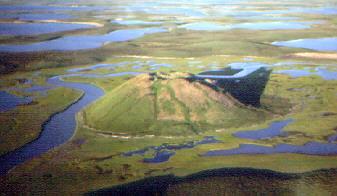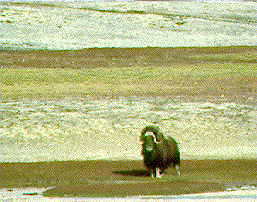
The Land
Beaufort Region
(Part II)
by
David Morrison
Curator of N.W.T. Archaeology
(District of Mackenzie)
Canadian Museum of Civilization
Vegetation
 By Arctic standards, vegetation cover is unusually dense and complete, and
bare ground is largely restricted to beaches. Low, moist areas, especially
near the tree line, can support dense, nearly impassable stands of
shoulder-high willow, while dry hilltops may support only a few scattered
shrubs. Open, grassy areas usually mark the location of former houses and
villages. Frost-patterned ground is common in many areas, as are the
characteristic pingos. These large "frost boils" take the form of earthen
hills several dozen to several hundred metres high, with frozen, icy
centres and cratered tops, like frozen volcanoes. They are more common in
the Tuktoyaktuk Peninsula area (where there are several thousand) than
anywhere else on earth.
By Arctic standards, vegetation cover is unusually dense and complete, and
bare ground is largely restricted to beaches. Low, moist areas, especially
near the tree line, can support dense, nearly impassable stands of
shoulder-high willow, while dry hilltops may support only a few scattered
shrubs. Open, grassy areas usually mark the location of former houses and
villages. Frost-patterned ground is common in many areas, as are the
characteristic pingos. These large "frost boils" take the form of earthen
hills several dozen to several hundred metres high, with frozen, icy
centres and cratered tops, like frozen volcanoes. They are more common in
the Tuktoyaktuk Peninsula area (where there are several thousand) than
anywhere else on earth.
Animal Resources
The Western Arctic is also very well endowed with animal resources. Particularly important are beluga whales, a small circumpolar white whale about 4 metres in length. In summer, they are very abundant in the esutaries of the Mackenzie River mouth, where they are much hunted. There area also much larger bowhead whales, baleen whales up to 18 metres in length. The mainstay of Arctic commercial whaling, bowheads were nearly exterminated in the Western Arctic before the First World War, but are making a cautious comeback today. Seals are found everywhere in the Arctic sea. The two main species
in the Western Arctic are ringed seals, the common and typical arctic
seal, and the much larger bearded seal. Unlike the larger sea mammals
both species can easily deal with even complete ice cover by maintaining
breathing holes through the ice. Both are found in the area year round.
Seals are found everywhere in the Arctic sea. The two main species
in the Western Arctic are ringed seals, the common and typical arctic
seal, and the much larger bearded seal. Unlike the larger sea mammals
both species can easily deal with even complete ice cover by maintaining
breathing holes through the ice. Both are found in the area year round.
On land, fish are a staple food resource, particularly cisco, whitefish, and burbot. Most are summer spawners, and can be taken in huge numbers with nets.
 The Western Arctic is served by two distinct caribou herds, with the
Porcupine herd living west of the River, and the Bluenose herd to the
east. Both are migratory, calving on the coastal tundra in early June,
and wintering in the northern forests. Perhaps due to overhunting during
the whaling era, both caribou populations collapsed in the early
20th century, but are in strong recovery today. The best caribou hunting
is in the Richardson Mountains, or to the east around the Anderson River.
With fish and sea mammals, caribou were the basis of traditional
subsistence in the Western Arctic.
The Western Arctic is served by two distinct caribou herds, with the
Porcupine herd living west of the River, and the Bluenose herd to the
east. Both are migratory, calving on the coastal tundra in early June,
and wintering in the northern forests. Perhaps due to overhunting during
the whaling era, both caribou populations collapsed in the early
20th century, but are in strong recovery today. The best caribou hunting
is in the Richardson Mountains, or to the east around the Anderson River.
With fish and sea mammals, caribou were the basis of traditional
subsistence in the Western Arctic.
There are other, larger animals. Polar bears are the largest terrestrial carnivores on earth, and can sometimes be found in coastal regions,
 particularly around the outer headlands such as Cape Bathurst.
Occasionally they wander inland as far as Fort MacPherson or Arctic Red
River. More common are grizzly bears, which are relatively abundant in the
Richardson Mountains, or east of the River around the Horton and Anderson
Rivers. Moose occasionally wander north of treeline in summer, browsing
on rich willow thickets. And muskox can be found in a few areas. By
1900 they were extinct in Alaska and all but eliminated west of Coronation
Gulf, but like many other Arctic animals they are making a good comeback
in the 20th century. Muskox can now be seen around the Horton River, and
also on the Yukon Arctic coast, where an introduced Alaskan population is
expanding. They were probably never common in the Mackenzie valley itself.
particularly around the outer headlands such as Cape Bathurst.
Occasionally they wander inland as far as Fort MacPherson or Arctic Red
River. More common are grizzly bears, which are relatively abundant in the
Richardson Mountains, or east of the River around the Horton and Anderson
Rivers. Moose occasionally wander north of treeline in summer, browsing
on rich willow thickets. And muskox can be found in a few areas. By
1900 they were extinct in Alaska and all but eliminated west of Coronation
Gulf, but like many other Arctic animals they are making a good comeback
in the 20th century. Muskox can now be seen around the Horton River, and
also on the Yukon Arctic coast, where an introduced Alaskan population is
expanding. They were probably never common in the Mackenzie valley itself.



